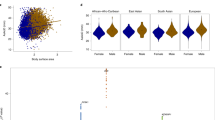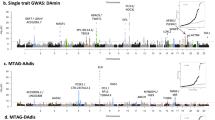Abstract
Objectives
Previous studies using transthoracic echocardiography (TTE) observed moderate heritability of aortic root dimensions. Computed tomography angiography (CTA) might provide more accurate heritability estimates. Our primary aim was to assess the heritability of the aortic root with CTA. Our secondary aim was to derive TTE-based heritability and compare this with the CTA-based results.
Methods
In the BUDAPEST-GLOBAL study 198 twin subjects (118 monozygotic, 80 dizygotic; age 56.1 ± 9.4 years; 126 female) underwent CTA and TTE. We assessed the diameter of the left ventricular outflow tract (LVOT), annulus, sinus of Valsalva, sinotubular junction and ascending aorta. Heritability was assessed using ACDE model (A additive genetic, C common environmental, D dominant genetic, E unique environmental factors).
Results
Based on CTA, additive genetic effects were dominant (LVOT: A = 0.67, E = 0.33; annulus: A = 0.76, E = 0.24; sinus of Valsalva: A = 0.83, E = 0.17; sinotubular junction: A = 0.82, E = 0.18; ascending aorta: A = 0.75, E = 0.25). TTE-derived measurements showed moderate to no genetic influence (LVOT: A = 0.38, E = 0.62; annulus: C = 0.47, E = 0.53; sinus of Valsalva: C = 0.63, E = 0.37; sinotubular junction: C = 0.45, E = 0.55; ascending aorta: A = 0.67, E = 0.33).
Conclusion
CTA-based assessment suggests that aortic root dimensions are predominantly determined by genetic factors. TTE-based measurements showed moderate to no genetic influence. The choice of measurement method has substantial impact on heritability estimates.
Key Points
• Aortic root dimensions are determined by genetic and environmental effects.
• Transthoracic echocardiography (TTE) demonstrated moderate to no genetic effects on aortic root dimensions.
• Computed tomography angiography might provide more accurate heritability estimates compared to TTE.
• Three-dimensional imaging techniques are needed to reliably quantify aortic root dimensions.



Similar content being viewed by others
Abbreviations
- ACDE:
-
additive genetic, common environment, dominant genetic, unique environment
- BMI:
-
body mass index
- CTA:
-
computed tomography angiography
- DZ:
-
dizygotic twins
- ECG:
-
electrocardiography
- ICC:
-
intraclass correlation
- LVOT:
-
left ventricular outflow tract
- MZ:
-
monozygotic twins
- TTE:
-
transthoracic echocardiography
References
Ho SY (2009) Structure and anatomy of the aortic root. Eur J Echocardiogr 10:i3–i10
Isselbacher EM (2005) Thoracic and abdominal aortic aneurysms. Circulation 111:816–828
Lebowitz NE, Bella JN, Roman MJ et al (2000) Prevalence and correlates of aortic regurgitation in American Indians: the Strong Heart Study. J Am Coll Cardiol 36:461–467
Roman MJ, Devereux RB, Niles NW et al (1987) Aortic root dilatation as a cause of isolated, severe aortic regurgitation. Prevalence, clinical and echocardiographic patterns, and relation to left ventricular hypertrophy and function. Ann Intern Med 106:800–807
Eisenberg MJ, Rice SA, Paraschos A, Caputo GR, Schiller NB (1993) The clinical spectrum of patients with aneurysms of the ascending aorta. Am Heart J 125:1380–1385
Nicod P, Bloor C, Godfrey M et al (1989) Familial aortic dissecting aneurysm. J Am Coll Cardiol 13:811–819
Bella JN, MacCluer JW, Roman MJ et al (2002) Genetic influences on aortic root size in American Indians: the strong heart study. Arterioscler Thromb Vasc Biol 22:1008–1011
Roman MJ, Devereux RB, Kramer-Fox R, O'Loughlin J (1989) Two-dimensional echocardiographic aortic root dimensions in normal children and adults. Am J Cardiol 64:507–512
Vasan RS, Larson MG, Levy D (1995) Determinants of echocardiographic aortic root size. The Framingham heart study. Circulation 91:734–740
Lam CS, Xanthakis V, Sullivan LM et al (2010) Aortic root remodeling over the adult life course: longitudinal data from the Framingham heart study. Circulation 122:884–890
Kim M, Roman MJ, Cavallini MC, Schwartz JE, Pickering TG, Devereux RB (1996) Effect of hypertension on aortic root size and prevalence of aortic regurgitation. Hypertension 28:47–52
Covella M, Milan A, Totaro S et al (2014) Echocardiographic aortic root dilatation in hypertensive patients: a systematic review and meta-analysis. J Hypertens 32:1928–1935, discussion 1935
Jin Y, Kuznetsova T, Bochud M et al (2011) Heritability of left ventricular structure and function in Caucasian families. Eur J Echocardiogr 12:326–332
Tzikas A, Schultz CJ, Piazza N et al (2011) Assessment of the aortic annulus by multislice computed tomography, contrast aortography, and trans-thoracic echocardiography in patients referred for transcatheter aortic valve implantation. Catheter Cardiovasc Interv 77:868–875
Schuhbaeck A, Achenbach S, Pflederer T et al (2014) Reproducibility of aortic annulus measurements by computed tomography. Eur Radiol 24:1878–1888
Lu TL, Huber CH, Rizzo E, Dehmeshki J, von Segesser LK, Qanadli SD (2009) Ascending aorta measurements as assessed by ECG-gated multi-detector computed tomography: a pilot study to establish normative values for transcatheter therapies. Eur Radiol 19:664–669
Rixe J, Schuhbaeck A, Liebetrau C et al (2012) Multi-detector computed tomography is equivalent to trans-oesophageal echocardiography for the assessment of the aortic annulus before transcatheter aortic valve implantation. Eur Radiol 22:2662–2669
Ocak I, Lacomis JM, Deible CR, Pealer K, Parag Y, Knollmann F (2009) The aortic root: comparison of measurements from ECG-gated CT angiography with transthoracic echocardiography. J Thorac Imaging 24:223–226
Maurovich-Horvat P, Tarnoki DL, Tarnoki AD et al (2015) Rationale, design, and methodological aspects of the BUDAPEST-GLOBAL study (burden of atherosclerotic plaques study in twins-genetic loci and the burden of atherosclerotic lesions). Clin Cardiol 38:699–707
Littvay L, Metneki J, Tarnoki AD, Tarnoki DL (2013) The Hungarian twin registry. Twin Res Hum Genet 16:185–189
Litmanovich D, Zamboni GA, Hauser TH, Lin PJ, Clouse ME, Raptopoulos V (2008) ECG-gated chest CT angiography with 64-MDCT and tri-phasic IV contrast administration regimen in patients with acute non-specific chest pain. Eur Radiol 18:308–317
Achenbach S, Delgado V, Hausleiter J, Schoenhagen P, Min JK, Leipsic JA (2012) SCCT expert consensus document on computed tomography imaging before transcatheter aortic valve implantation (TAVI)/transcatheter aortic valve replacement (TAVR). J Cardiovasc Comput Tomogr 6:366–380
Lang RM, Bierig M, Devereux RB et al (2005) Recommendations for chamber quantification: a report from the American Society of echocardiography's guidelines and standards committee and the chamber quantification writing group, developed in conjunction with the European association of echocardiography, a branch of the European society of cardiology. J Am Soc Echocardiogr 18:1440–1463
Neale M (1992) Methodology for genetic studies of twins and families. Springer Netherlands, Dordrecht
R Core Team (2015) R: A language and environment for statistical computing. R Foundation for Statistical Computing, Vienna
Kottner J, Audige L, Brorson S et al (2011) Guidelines for Reporting Reliability and Agreement Studies (GRRAS) were proposed. J Clin Epidemiol 64:96–106
Neale MC, Hunter MD, Pritikin JN et al (2015) OpenMx 2.0: extended structural equation and statistical modeling. Psychometrika. doi:10.1007/s11336-014-9435-8
Thomas Lumley using Fortran code by Alan Miller (2009) Leaps: regression subset selection. R package version 2.9
Messika-Zeitoun D, Serfaty JM, Brochet E et al (2010) Multimodal assessment of the aortic annulus diameter: implications for transcatheter aortic valve implantation. J Am Coll Cardiol 55:186–194
Tops LF, Wood DA, Delgado V et al (2008) Noninvasive evaluation of the aortic root with multislice computed tomography implications for transcatheter aortic valve replacement. JACC Cardiovasc Imaging 1:321–330
Acknowledgments
The authors thank Levente Littvay, PhD, from the Central European University (Budapest, Hungary) for his instrumental help in the statistical analysis. The scientific guarantor of this publication is Pál Maurovich-Horvat MD, PhD, MPH. The authors of this manuscript declare relationships with the following companies: Szilard Voros, MD, is a shareholder in Global Genomics Group, LLC, and receives salary from Global Genomics Group, LLC. This study has received funding by a grant from the EFSD (European Foundation for the Study of Diabetes) New Horizons Program to György Jermendy, MD. Global Genomics Group contributed funding for CT imaging and blood-based biomarker measurements. One of the authors has significant statistical expertise. Institutional review board approval was obtained. Written informed consent was obtained from all subjects (patients) in this study. Methodology: prospective, classical twin study, performed at one institution.
Author information
Authors and Affiliations
Corresponding author
Additional information
Béla Merkely and Pál Maurovich-Horvat contributed equally to this work.
Electronic supplementary material
Below is the link to the electronic supplementary material.
Supplementary Table 1
(DOCX 48 kb)
Supplementary Table 2
(DOCX 48 kb)
Rights and permissions
About this article
Cite this article
Celeng, C., Kolossváry, M., Kovács, A. et al. Aortic root dimensions are predominantly determined by genetic factors: a classical twin study. Eur Radiol 27, 2419–2425 (2017). https://doi.org/10.1007/s00330-016-4590-1
Received:
Revised:
Accepted:
Published:
Issue Date:
DOI: https://doi.org/10.1007/s00330-016-4590-1




